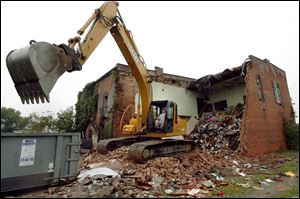
Group effort gets eyesores taken down
10/3/2006
Equipment operator Scott Apple demolishes a nuisance property on Sugar St. in Milton Center.
BOWLING GREEN - When a three-story building in downtown North Baltimore became so run down that inspectors feared it would fall down back in 2001, Wood County health officials decided to find a way to eliminate similar health and safety hazards.
With funding from the cities, villages, and townships in the county, the health department created a demolition program for condemned buildings that's considered one-of-a-kind in the state. Most of the 15 or so buildings that have come down since have been targeted because of complaints the health department has received from neighbors.
"We don't like telling neighboring property owners that we can't do anything about it," said Brad Espen, acting health commissioner. "We obviously have to be very careful when we proceed with something like this, but it's proven to be a good program."
To get the authority to tear down a privately owned structure, the county must first order the property owner to make the repairs. If that doesn't work, they have to have the structure condemned, hold an administrative hearing where the property owner is invited, then get bids for demolition and approval from the board of health to move forward.
Last month, the board of health gave final approval to demolition plans for five properties, including a former commercial building in Milton Center that a contractor began tearing down yesterday; a house on King Road near Haskins, and three houses in the Perrysburg Heights neighborhood in Perrysburg Township.
Anita Serda, president of the Perrysburg Heights Community Association, said the organization has been trying for years to get something done about those eyesores and others.
"For us, the issue obviously is the safety of the kids and the community," Ms. Serda said. "Some of these places have been condemned. Some are partially torn down. There are others that have caught fire. They have broken out windows, overgrown grass; then people dump trash on the properties."
She said the health department's involvement is welcome relief.
"I think it's going to be very uplifting for the community because the individuals who have lived next to these homes have been fighting for years for this," she said.
Milton Center Mayor Albert Torres, Jr., said the same about the condemned building in his western Wood County village.
"We were afraid someone was going to get hurt," he said. "We're just lucky no kid set fire to it."
Mr. Espen said safety is the biggest impetus for the demolition program.
"If you have a vacant structure, it's attractive to children. It's attractive to vermin too," he said. "There are many reasons to tear them down."
Funding for the program, which has ranged from $10,000 to $30,000 a year, comes out of property tax collections paid to townships and municipalities.
Mr. Espen said demolition costs average $6,000 to $7,000 per structure, and the health department tries to get help from townships and municipalities where the buildings are located. Some have donated the use of a backhoe or dump truck, for example. The health department also has gotten the fire school held each year at Bowling Green State University to burn down some of the condemned buildings.
Mr. Espen said he's gotten inquiries about the program from county health departments across the state, but he's unaware of any that have been able to duplicate it. He said most tell him they can't get other local and county agencies to get on board.
"It's all of us working together that has made this program successful," he said, referring to the budget commission, prosecutor, building inspection department, and local officials. "If we weren't working together, the program wouldn't be there. If we didn't have the funding, it wouldn't exist."
Contact Jennifer Feehan at:
jfeehan@theblade.com
or 419-353-5972.